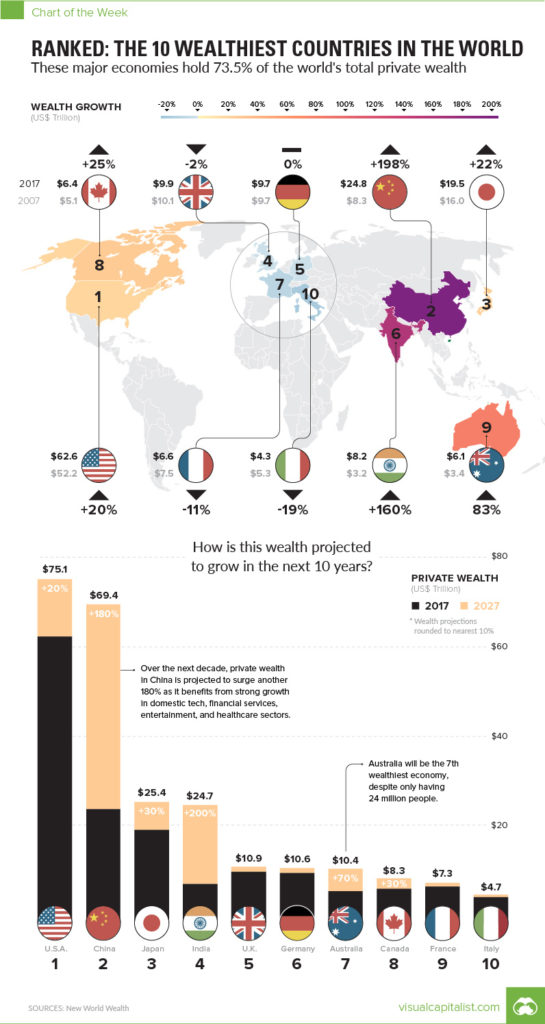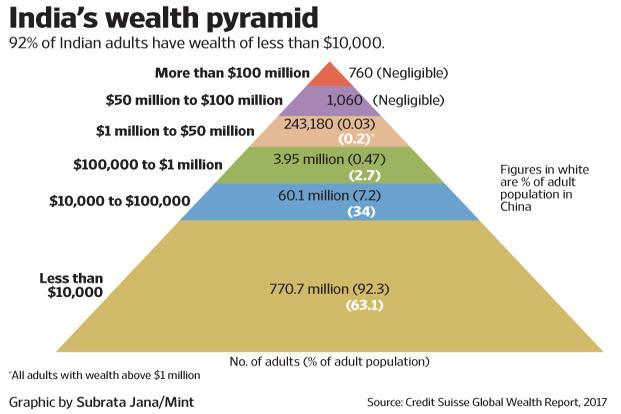Recently, Visual Capitalist created a chart ranking the 10 wealthiest countries in the world. India ranks sixth on that chart. It didn’t surprise me to see India ranked so high, higher than France, Canada, Australia and Italy. However what caught my eye was the percentage growth in private wealth in India, in the last 10 years (2007-2017). India’s private wealth, at $8.2 trillion, grew 160 per cent in the last decade, second only to China’s, which grew 198 per cent. According to Visual Capitalist, in the next 10 years, “India is expected to shoot up 200 per cent to claim the #4 position with $24.7 trillion in private wealth.” In the next decade, India’s percentage growth in private wealth—200 per cent—will be highest in the world, beating China’s, which is projected to go up by 180 per cent.

The top 10 wealthiest country in the world. Courtesy of: Visual Capitalist
Now, for many people this is wonderful news to hear—India is growing at a stupendous rate, which is resulting in the growth of private wealth. It should only mean that wealth is trickling down, thereby uplifting lives, eliminating poverty and developing the nation. That’s a real success story for any country, a developing country especially. That observation is right on the money, unless you are willing to peel back the layers, pull back the curtains to reveal the hard truth.
Private wealth
The reality on the ground is actually frightening and is quite different from what the headline numbers reveal. Income inequality and wealth inequality is growing in India. According to a report published by Oxfam, an international rights group, in 2017, the top one per cent of Indians captured 73 per cent of the wealth generated in the country. On the other hand, the poorest half of the population, around 67 crores (670 million) saw their wealth increase by just one percent, in 2017.
In 2016, a similar study by Oxfam revealed that the richest one per cent in India hold 58 per cent of the country’s wealth. This is higher than the global average of about 50 per cent. The Oxfam study also found that India has a total of 84 billionaires, whose collective wealth equals to $248 billion. If we look globally, the total wealth of 8 billionaires equals the total wealth of the poorest 50 per cent of the world’s population. Wow!
Wealth pyramid
Furthermore, the latest Global Wealth Report by Credit Suisse shows that 92.3 per cent of adult Indians have wealth less than $10,000 (~INR 67,000). 7.2 per cent of adult Indians have $10,000 to $100,000 in wealth. Only 0.5% of the Indians have over $100,000 in wealth. The Credit Suisse’s wealth report also mentions that the top 10 per cent of the country’s population hold 73 per cent of the wealth. In addition, it notes that 37 per cent of the billionaires in India have inherited family wealth and those billionaires own “51% of the total wealth of billionaires in the country.“

India’s wealth pyramid. Courtesy of: Live Mint
Basically, the Credit Suisse’s report indicates that India does not have a middle class. The Indian society is divided into two categories—the poor majority and the rich few. This is the reality of wealth inequality in India. The headline numbers are fantastic, provided we ignore what’s behind the curtain. If you think about this further, the 0.5 per cent of the Indians, in other words, the richest 100 Indians on this Forbes’ list probably own almost three-quarters of the country’s wealth. Mind boggling for a country growing at close to 8 per cent per year. Such a staggering divide between the haves and the have-nots might lead to an epic blowback in the not so distant future.
An Indian Arab Spring?
If the current trend in wealth isolation continues, then, the next decade or two might see the top 10 per cent owning almost 90 per cent of India’s wealth. This may mean that just a few billionaires own almost everything. Think about this for a moment—in a nation of close to 1.30 billion, just a handful of ultra-rich people may end up owning the lion’s share of the country’s wealth.
Can you now imagine the kind of wealth inequality we might experience in the country, in the next couple of decades? Can such a wealth gap cause massive discontentment among the underprivileged and the have-nots, and eventually lead to an Indian Arab Spring? The possibilities aren’t that remote, from my vantage point and from what I see on the ground. People in poverty are hurting and they are angry.
However, the overlords have nothing to fear. Even if protests, uprisings, and demonstrations were to take place in India, the ultra-rich and the elites will go through such an event unscathed. They always do. As I oft say, The elites rarely get hurt, only the plebes get slaughtered.
